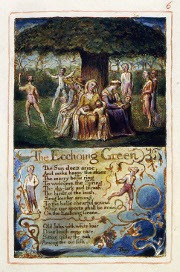Songs of Innocence and Experience Contents
The Ecchoing Green - Imagery, symbolism and themes
Imagery and symbolism
Spring - Blake uses the image of spring because of its associations with growth and fertility. Spring is also the season for the birth of animals, for the appearance of flowers after winter, for birdsong. All of these represent what is natural, new and uncorrupted. They therefore suit the expression of innocence.
Play - Blake links the play of the children to the coming of spring to emphasise the relationship between the two. Children, in these poems, are fresh and untouched by experience; they share the freedom and naturalness of the birds. Play is also associated with youth. It reminds the elders of their own youth, but there is a sense that it does not survive the ending of the day / the ending of childhood.
The green - Blake develops his own symbols in these poems as well as using established ones. Here he begins his image of the green, usually the village green. This has three, inter-linked, aspects:
- The colour green is associated with growth, fertility and spring
- Village greens were places of play and freedom. They represented the importance of play, and therefore of imagination, in human life
- Village greens were not owned by anyone but were common land. They therefore represented another kind of freedom, freedom from the rule or demands of a landowner or authority figure. They were the opposite of ‘chartered' towns which were under the authority of their officials.
Investigating imagery and symbolism
- Read the poem again and see how the associations with ‘green' give added meaning to the poem
Themes
The nature of innocence
Innocence here is freedom from constraint and self-consciousness. The children are without self-awareness in their play, as instinctive in their behaviour as the birds. They are also full of trust in their world, both natural and human. The fragility of this state is also an aspect of this theme.
The nature of authority
The old people here are like the shepherd in The Shepherd, in that they enjoy being with the children (lambs). They do not use the authority of age to repress the young ones' imagination and instincts.
Liberation: This relates to childhood play and, therefore, of the imagination which this represents.
Investigating themes
- Watch for new and possibly contradictory views of innocence in the other poems in this sequence.
Related material
Scan and go

Scan on your mobile for direct link.
